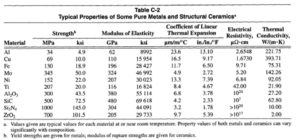Ceramics are inorganic nonmetallic materials separable into two broad categories: traditional ceramics and advanced ceramics. A common characteristic of ceramic materials is that they are manufactured from powders which are formed to a desired shape, and then heated to high temperature with or without the application of external pressure to achieve a final densified
part.
Traditional ceramics include clay products, refractories, silicate glasses, and cements. They are most commonly made from inexpensive, readily available, naturally occurring minerals. These materials typically have low densities (or relatively high porosity contents) and normally are not used in applications where joining by techniques other than cementing is practical.
Advanced ceramics, by comparison, are made from powders that are chemically processed or synthesized and in which properties such as particle size distribution and chemical purity are closely controlled. Within the family of advanced ceramics are materials developed for their exceptional mechanical properties. This subset of advanced ceramics is often referred to as
structural ceramics, and it includes monolithic materials such as aluminum oxide (A1203), zirconium oxide (Zr02), silicon carbide (Sic), silicon nitride (Si3N4), and silicon-aluminum oxynitrides (sialons), as well as ceramic composites like A1203 containing Sic whiskers or Sic containing titanium diboride (TiB,) particles. Care is taken during the manufacture of structural
ceramics to ensure that chemical composition is controlled and that high densities (or relatively low porosity contents) are achieved.
The technological interest in structural ceramics is directly related to their unique properties when they are compared to metals. Many ceramics are characterized by high strength, not only at room temperature but at elevated temperatures as well. Silicon carbide, for example, can maintain a tensile strength in excess of 200 MPa (29 ksi) at 1530°C (2800″F),the melting
point of iron. Other ceramics, like Si3N4 and certain ceramic composites, also maintain high strength at high temperatures. Besides high strength, other properties that make ceramics attractive candidates for applications usually reserved for metallic alloys
include excellent wear resistance, high hardness, excellent corrosion and oxidation resistance, low thermal expansion, high electrical resistivity, and high strength-to-weight ratio. Structural ceramics are being used or considered for use as cutting tools, bearings, machine tool parts, dies, pump seals, high temperature heat exchangers, and a variety of internal combustion and turbine engine parts. Typical properties for some metals and structural ceramic materials are given in
Table C-2.
Ceramic joining, especially ceramic-to-metal joining, has been the subject of much developmental research over the years. However, with high interest in using ceramics as structural components in demanding applications, such as internal combustion engines, turbine engines, and heat exchangers, there is a heightened interest in ceramic joining technologies. The
development of more effective joining techniques for structural ceramics could also have a great impact on their use in mass-produced components.
One of the most important functions of joining techniques is to provide the means for economic fabrication of complex, multi-component structures. Development of effective ceramic joining techniques will be especially significant because of limitations on component manufacturing due to ceramic processing techniques and to the materials themselves. For example, deformation of densified ceramics to form complex shapes is practically impossible because most ceramic materials are brittle even at elevated temperatures. Also, in some development programs like those for advanced heat engines, some complex parts are being made as monoliths by difficult processing schemes or by extensive machining of densified billets.
While this approach to component manufacturing is acceptable for development purposes, it is impractical for mass production because of high costs. The difficulty of machining ceramics also makes it costly. By reducing the complexity of individual parts, significant reductions in machining cost can be expected. Effective methods of joining ceramics may eliminate machining altogether in some cases.
Effective ceramic joining techniques also can play an important role in improving the reliability of ceramic structures. Because ceramics are brittle materials, they are very sensitive to flaws resulting from the quality of raw materials used in their production and to the characteristics of various processing techniques, including machining. A single flaw can cause the
rejection or, or if undetected, the failure of a ceramic part. Rather than dealing with complicated monolithic parts, it is easier to inspect and detect flaws in simple shaped components before they are joined to form complex structures.

The electronics industry has the largest fraction of advanced ceramics actually in use. Also, while the development of materials like zirconium oxide, silicon nitride, and silicon carbide has been rigorously pursued in recent years, aluminum oxide is still the most widely used structural ceramic with a sizable commercial electronics market. Reference: American Welding Society, Welding Handbook, Vol3, 8th Edition. Miami, Florida, 1996.
